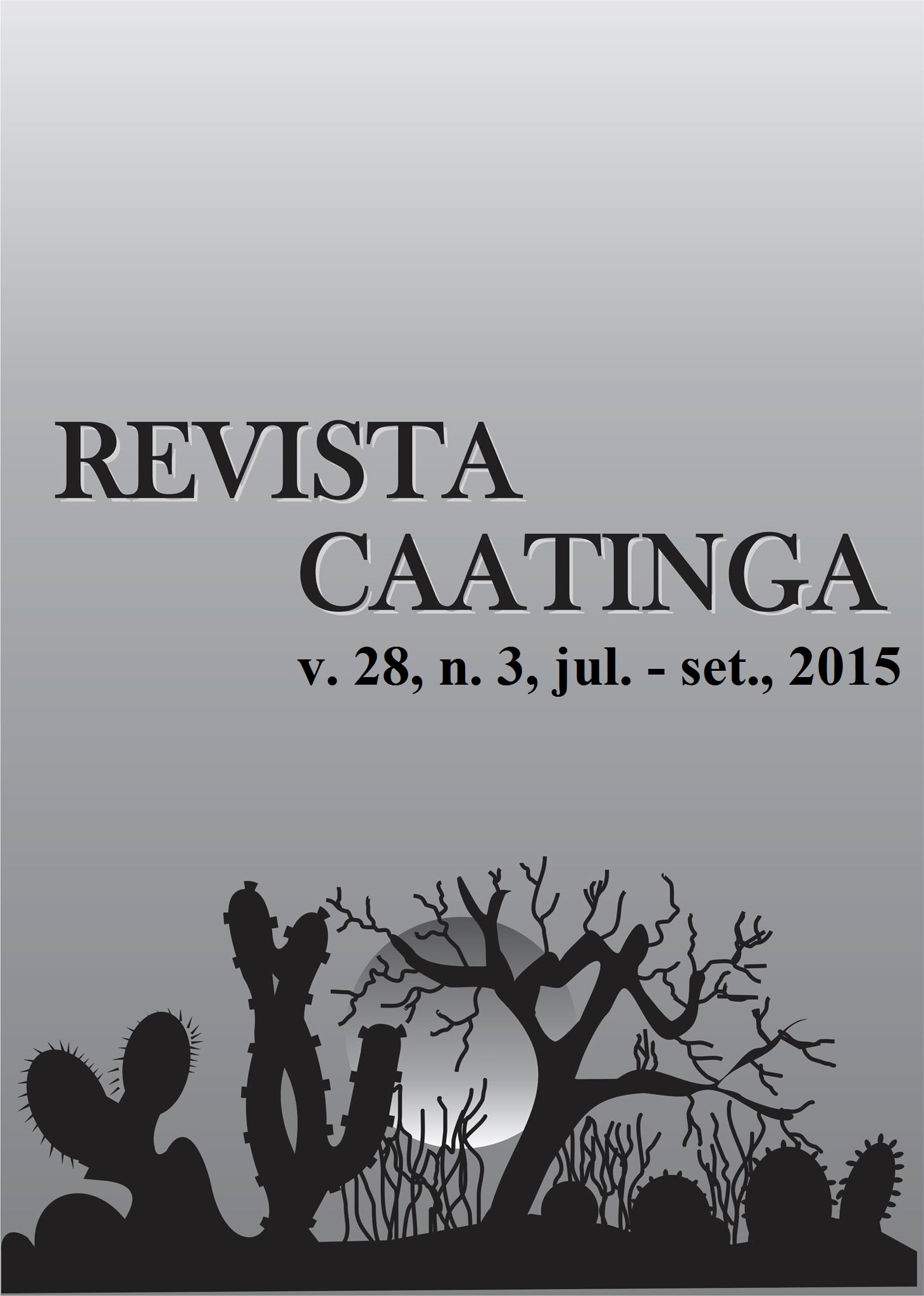MICROBIAL POPULATION, NUTRIENT AVAILABILITY, AND GROWTH OF UMBU ON SUBSTRATES WITH ORGANIC RESIDUES
DOI:
https://doi.org/10.1590/1983-21252015v28n305rcKeywords:
Spondias tuberosa. Total bactéria. Basal respiration. Plantmax® . Multivariate analysis.Abstract
The umbu is an important fruit for the northeast of Brazil because it is being used in reforestation areas and has great economic potential. However, there is a gap on propagation techniques of this culture that is a crucial step for the successful of plant development. Thus, the objective of the present study was to evaluate the effects of alternative substrate on the growth of umbu rootstock, fertility attributes, and microbial populations of these mixtures.The experimental design was completely randomized with 10 treatments: TA = soil + sand (1:1); A = sand; ECSC = goat manure + Plantmax® (1:3); EBSC = manure + Plantmax® (1:3); ECA = goat manure + sand (1:3); EBA = manure + sand (1:3); ECBSC = manure + goat manure + Plantmax®(1:1:3); ECBA = manure + goat manure + sand (1:1:3); HSC = humus + Plantmax®(1:3) and HA = humus + sand (1:3),with four replications. The addition of residues promoted the quality of the umbu rootstock, especially when mixed with a commercial substrate composed of vegetable organic matter and expanded vermiculite. With multivariate clustering, three groups acknowledged a similarity between the substrate mixtures. The use of humus or goat manure mixed with the commercial substrate is recommended for the production of umbu rootstock.Downloads
References
ANDRADE, M. W. et al. Adubos nitrogenados e potássicos na produção de porta-enxertos de umbuzeiro (Spondias tuberosa Arr. Cam.). Revista Caatinga, Mossoró, v. 26, n. 4, p. 117–122, 2013.
ARAÚJO, W. B. M. et al. Esterco caprino na composição de substratos para formação de mudas de mamoeiro. Ciência & Agrotecnologia, Lavras, v. 34, n. 1, p. 68-73, 2010.
BRITO, O. R. et al. Alterações das propriedades químicas de um Latossolo Vermelho distroférrico submetido ao tratamento com resíduos orgânicos. Semina: Ciências Agrárias, Londrina, v. 26, n. 1, p.33-40, 2005.
CRITTER, S.A.M. et al. Comparison between microorganism couting and a calorimetric method applied to tropical soils. Thermochimica Acta, Germany, v.394, n.1, p.133-144, 2002.
EMBRAPA. Manual de análises químicas de solos, plantas e fertilizantes. Brasília: Embrapa Informação Tecnológica,2009. 627 p.
EMBRAPA. Sistema brasileiro de classificação de solos. Brasília, DF: 2006. 306 p.
FACHINELLO, J. C. et al. Propagação de plantas frutíferas. Brasília: Embrapa Informação Tecnológica, 2005. 221 p.
JOHNSON, L. F.; CURL, E .A. Methods for research on the ecology of soil-borne plant pathogens. Minneapolis: Burgess, 1972. 235 p.
MEDEIROS, E.V. et al. Absolute and specific enzymatic activities of sandy entisol from tropical dry forest, monoculture and intercropping areas. Soil and Tillage Research, South Carolina, v. 145, n.1, p. 208-215, 2015.
MENDONÇA, E. S; MATOS, E. da S. Matéria orgânica do solo: Métodos de análises. 1.ed. Viçosa, UFV, 2005. 107 p.
MENDONÇA, V. et al. Avaliação de diferentes substratos na produção de porta-enxertos de tamarindeiro. Revista Caatinga, Mossoró, v. 27, n. 1, p. 60–66, 2014.
MERCANTE, F. M. et al. Parâmetros microbiológicos como indicadores da qualidade do solo sob diferentes sistemas integrados de produção agropecuária. Dourados, Embrapa Agropecuária Oeste, 2004. 27 p. (Embrapa Agropecuária Oeste. Boletim de pesquisa e desenvolvimento, 20).
MOLLITOR, H. D. et al. Peat substitute on the basis of recycled wood chipboard. Acta Horticulturae, Belgium, v. 644, n. 1, p. 123- 130, 2004.
NEVES, O.S.C. Umbuzeiro (Spondias tuberosa Arr. Câm.): uma alternativa para o semiárido. Vitória da Conquista, Edições UESB, 2010. 96 p.
NOTARO, K. A. et al. População microbiana rizosférica, disponibilidade de nutrientes e crescimento de pinheira em substratos com resíduos orgânicos. Revista Brasileira de Ciências Agrárias, Recife, v. 7, n.1, p.770-776, 2012.
NOVAIS, R. F.; SMYTH, T. J. ; NUNES, F. N. ed. Fertilidade do solo. Viçosa, MG, Sociedade Brasileira de Ciência do Solo, 2007. 1017 p.
RODRIGUES, B. M. et al. Tolerance to water deficit in young trees of jackfruit and sugar apple. Revista Ciência Agronômica, Fortaleza, v. 41, n. 2, p. 245-252, 2010.
SANTOS, A. C. V. Produção de mudas florestais. Niterói: Programa Rio Rural, 2008. Manual Técnico, 06, 20 f.
SILVA, C. et al. Interferência da incorporação de matéria orgânica no solo no controle da podridão negra da mandioca, causada por Scytalidium lignicola. Bioscience Journal, Uberlândia, v. 29, n. 6, p.1823-1831, 2013.
STATISTICA (data analysis software system), version 7.0, StatSoft. 2004. Disponível em:< http://www.statsoft.com/>. Acesso em: 21 abr. 2014.
ZIETEMANN, C.; ROBERTO, S. R. Produção de mudas de goiabeira (Psidium guajava L.) em diferentes substratos. Revista Brasileira de Fruticultura, Jaboticabal, v. 29, n. 1, p. 137-142, 2007.
Downloads
Published
Issue
Section
License
Os Autores que publicam na Revista Caatinga concordam com os seguintes termos:
a) Os Autores mantêm os direitos autorais e concedem à revista o direito de primeira publicação, com o trabalho simultaneamente licenciado sob a Licença Creative Commons do tipo atribuição CC-BY, para todo o conteúdo do periódico, exceto onde estiver identificado, que permite o compartilhamento do trabalho com reconhecimento da autoria e publicação inicial nesta revista, sem fins comerciais.
b) Os Autores têm autorização para distribuição não-exclusiva da versão do trabalho publicada nesta revista (ex.: publicar em repositório institucional ou como capítulo de livro), com reconhecimento de autoria e publicação inicial nesta revista.
c) Os Autores têm permissão e são estimulados a publicar e distribuir seu trabalho online (ex.: em repositórios institucionais ou na sua página pessoal) a qualquer ponto antes ou durante o processo editorial, já que isso pode gerar alterações produtivas, bem como aumentar o impacto e a citação do trabalho publicado (Veja O Efeito do Acesso Livre).







